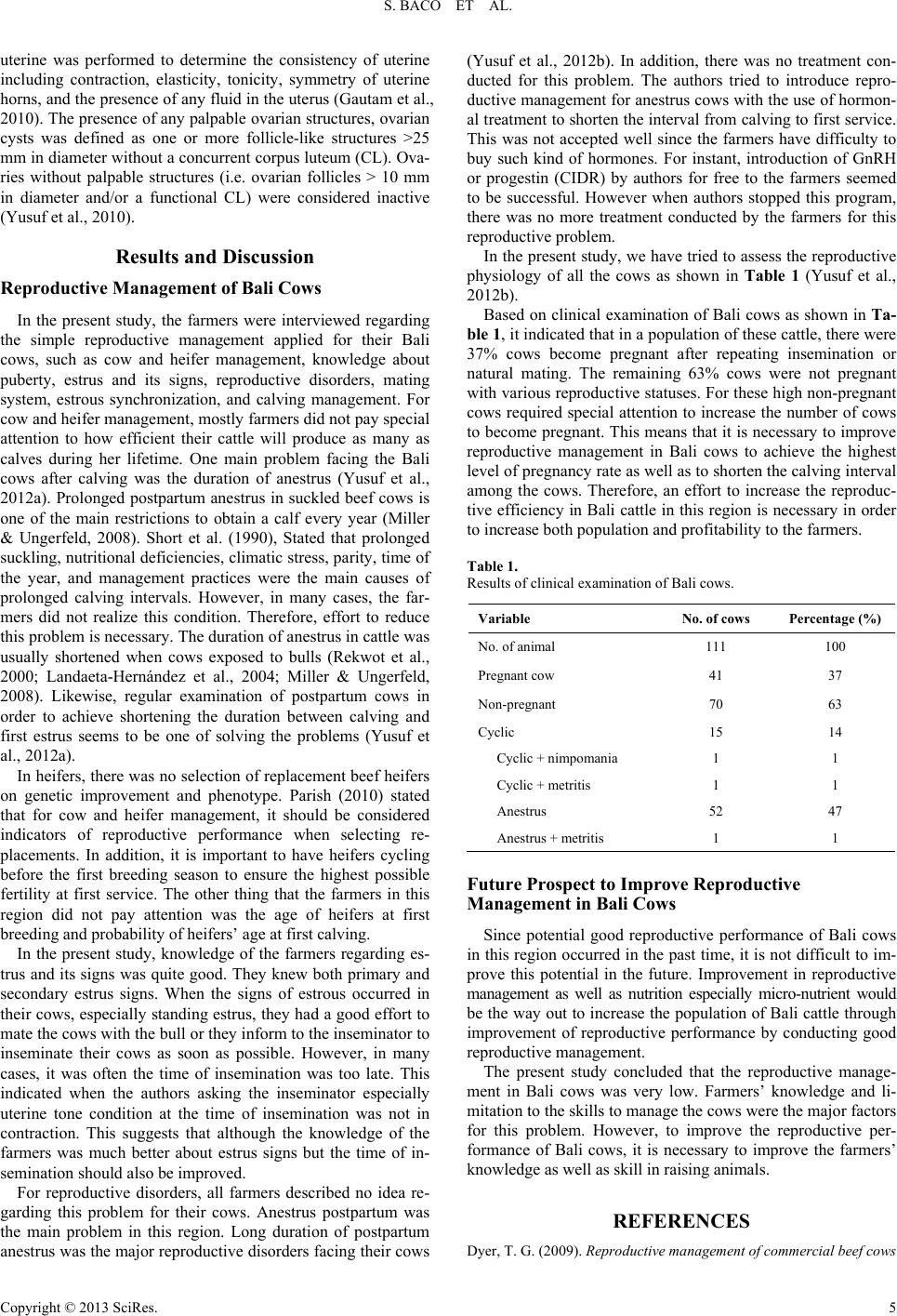
S. BACO ET AL.
Copyright © 2013 SciRes.
uterine was performed to determine the consistency of uterine
including contraction, elasticity, tonicity, symmetry of uterine
horns, and the presence of any fluid in the uterus (Gauta m et a l.,
2010). The presence of any palpable ovarian structures, ovarian
cysts was defined as one or more follicle-like structures >25
mm in diameter without a concurrent corpus luteum (CL). Ova-
ries without palpable structures (i.e. ovarian follicles > 10 mm
in diameter and/or a functional CL) were considered inactive
(Yusuf et al., 2010).
Results and Discussion
Reproductive Ma n a ge m ent of Bali Cows
In the present study, the farmers were interviewed regarding
the simple reproductive management applied for their Bali
cows, such as cow and heifer management, knowledge about
puberty, estrus and its signs, reproductive disorders, mating
system, estrous synchronization, and calving management. For
cow and heifer management, mostly farmers did not pay special
attention to how efficient their cattle will produce as many as
calves during her lifetime. One main problem facing the Bali
cows after calving was the duration of anestrus (Yusuf et al.,
2012a). Prolonged postpartum anestrus in suckled beef cows is
one of the main restrictions to obtain a calf every year (Miller
& Ungerfeld, 2008). Short et al. (1990), Stated that prolonged
suckling, nutritional deficiencie s, climatic stress, pa rity, time of
the year, and management practices were the main causes of
prolonged calving intervals. However, in many cases, the far-
mers did not realize this condition. Therefore, effort to reduce
this problem is necessary. The duration of anestrus in cattle was
usually shortened when cows exposed to bulls (Rekwot et al.,
2000; Landaeta-Hernández et al., 2004; Miller & Ungerfeld,
2008). Likewise, regular examination of postpartum cows in
order to achieve shortening the duration between calving and
first estrus seems to be one of solving the problems (Yusuf et
al., 2012a).
In heifers, there was no selection of replacement beef heifers
on genetic improvement and phenotype. Parish (2010) stated
that for cow and heifer management, it should be considered
indicators of reproductive performance when selecting re-
placements. In addition, it is important to have heifers cycling
before the first breeding season to ensure the highest possible
fertility at first service. The other thing that the farmers in this
region did not pay attention was the age of heifers at first
breeding and probability of heifers’ age at first calving.
In the present study, knowledge of the farmers regarding es-
trus and its signs was quite good. They knew both primary and
secondary estrus signs. When the signs of estrous occurred in
their cows, especially standing estrus, they had a good effort to
mate the cows with the bull or they inform to the inseminator to
inseminate their cows as soon as possible. However, in many
cases, it was often the time of insemination was too late. This
indicated when the authors asking the inseminator especially
uterine tone condition at the time of insemination was not in
contraction. This suggests that although the knowledge of the
farmers was much better about estrus signs but the time of in-
semination should also be improved.
For reproductive disorders, all farmers described no idea re-
garding this problem for their cows. Anestrus postpartum was
the main problem in this region. Long duration of postpartum
anestrus was t he major reproductive disorders facing their cows
(Yusuf et al., 2012b). In addition, there was no treatment con-
ducted for this problem. The authors tried to introduce repro-
ductive management for anestrus cows with the use of hormon-
al treatment to shorten the interval from calving to first service.
This was not accepted well since the farmers have difficulty to
buy such kind of hormones. For instant, introduction of GnRH
or progestin (CIDR) by authors for free to the farmers seemed
to be successful. However when authors stopped this program,
there was no more treatment conducted by the farmers for this
reproductive problem.
In the present study, we have tried to assess the reproductive
physiology of all the cows as shown in Table 1 (Yusuf et al.,
2012b).
Based on clinical examination of Bali cows as shown in Ta-
ble 1, it indicated that in a population of these cattle, there were
37% cows become pregnant after repeating insemination or
natural mating. The remaining 63% cows were not pregnant
with various reproductive statuses. For these high non-pregnant
cows required special attention to increase the number of cows
to become pregnant. This means that it is necessary to improve
reproductive management in Bali cows to achieve the highest
level of pregnancy rate as well as to shorten the calving interval
among the cows. Therefore, an effort to increase the reproduc-
tive efficiency in Bali cattle in this region is necessary in order
to increase both population and profitability to the farmers.
Table 1.
Results of clinical examination of Bali cows.
Variable No. of cows Percentage (%)
No. of animal 111 100
Pregnant cow 41 37
Non-pregnant 70 63
Cyclic 15 14
Cyclic + nimpomania 1 1
Cyclic + metritis 1 1
Anestrus 52 47
Anestrus + metritis 1 1
Future Prospect to Improve Reproductive
Management in Bali Cows
Since potential good reproductive performance of Bali cows
in this region occurred in the past time, it is not difficult to im-
prove this potential in the future. Improvement in reproductive
management as well as nutrition especially micro-nutrient would
be the way out to increase the population of Bali cattle through
improvement of reproductive performance by conducting good
reproductive management.
The present study concluded that the reproductive manage-
ment in Bali cows was very low. Farmers’ knowledge and li-
mitation to the skills to manage the cows were the major factors
for this problem. However, to improve the reproductive per-
formance of Bali cows, it is necessary to improve the farmers’
knowledge as well as skill in raising animals.
REFERENCES
Dyer, T. G. (2009). Reproductive management of commercial beef cows